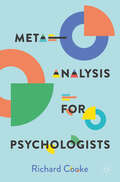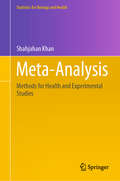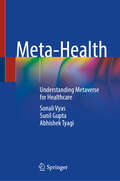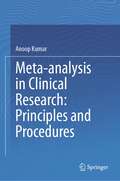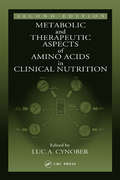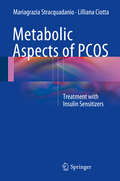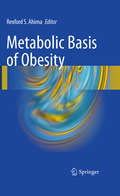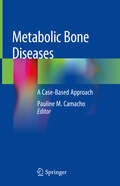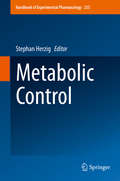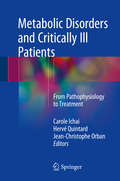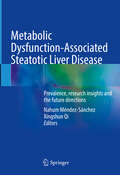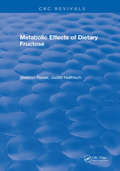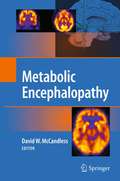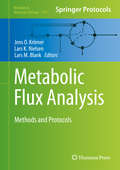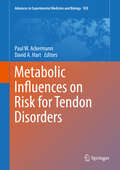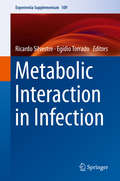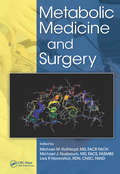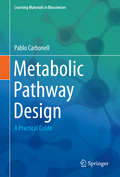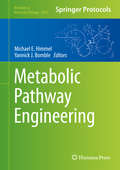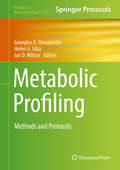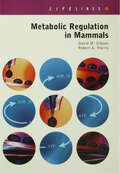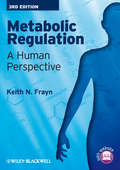- Table View
- List View
Messenger: The Legacy of Mattie J. T. Stepanek and Heartsongs
by Jeni Stepanek Larry LindnerIn Messenger, Jeni Stepanek shares the inspiring story of her son's life. Mattie was born with a rare disorder called Dysautonomic Mitochondrial Myopathy, and Jeni was advised to institutionalize him. Instead, she nurtured a child who transformed his hardships into a worldwide message of peace and hope.
Messung von Rückenmarksverletzungen: Ein praktischer Leitfaden für Outcome-Messungen
by Giovanni Galeoto Anna Berardi Marco Tofani Maria Auxiliadora MarquezDieses Buch beschreibt validierte Ergebnismessungen für die internationale Bevölkerung mit Rückenmarksverletzungen. Auf der Grundlage strenger systematischer Überprüfungen von ca. 80.000 wissenschaftlichen Artikeln stellen die Autoren Bewertungsinstrumente für verschiedene klinische Anwendungen in den Gesundheitswissenschaften vor und berücksichtigen dabei Parameter wie Validität, Zuverlässigkeit und Ansprechbarkeit.Für die Entwicklung der klinischen Praxis und der Forschung ist es wichtig, dass praktische und geeignete Messinstrumente allgemein akzeptiert werden; dies würde Vergleiche und Meta-Analysen von qualitativ hochwertigen randomisierten kontrollierten Studien mit Menschen mit dieser immer häufigeren Verletzung ermöglichen.Dieses Buch unterstreicht die Notwendigkeit eines Konsenses unter den Forschern darüber, welche Instrumente eingehend untersucht oder an andere nationale Kontexte angepasst werden müssen, oder welche Messinstrumente standardisiert werden sollten, um universelle Normen und Standards für die Leistung von Menschen mit Rückenmarksverletzungen zu entwickeln. Es bietet einen wertvollen praktischen Leitfaden für Kliniker, Rehabilitationsfachleute und Pflegepersonal, wird aber auch Forschern helfen, mehr Vertrauen in die Verwendung gültiger und zuverlässiger Bewertungsinstrumente für vergleichbare klinische Studien zu gewinnen.
Meta-Analysis for Psychologists
by Richard CookeThis textbook provides a comprehensive, user-friendly guide to meta-analysis and how to conduct it, using open source software and based on examples commonly found in the field of psychology. Meta-analysis is a key tool used in systematic literature reviews to synthesize research findings across studies, but despite being relatively straightforward to perform, it remains underused by psychologists. In the first section the reader is introduced to key ideas that underlie meta-analysis and how it might be best employed. Following this the reader is guided through how to run a meta-analysis of correlational studies and experimental studies using the free and open statistical software JAMOVI. In the concluding section Professor Cooke considers common issues, key debates and examines the relative merits of different analyses and different software packages.Covers theory, key issues and step-by-step demonstrationsIncludes examples worked examples familiar to psychologists and datasetsCompanion videos demonstrate the methods outlinedIt will provide a valuable new resource for postgraduate students and researchers in the behavioural and social sciences looking to enhance their methodological skills.
Meta-Analysis: Methods for Health and Experimental Studies (Statistics for Biology and Health)
by Shahjahan KhanThis book focuses on performing hands-on meta-analysis using MetaXL, a free add-on to MS Excel. The illustrative examples are taken mainly from medical and health sciences studies, but the generic methods can be used to perform meta-analysis on data from any other discipline. The book adopts a step-by-step approach to perform meta-analyses and interpret the results. Stata codes for meta-analyses are also provided. All popularly used meta-analytic methods and models – such as the fixed effect model, random effects model, inverse variance heterogeneity model, and quality effect model – are used to find the confidence interval for the effect size measure of independent primary studies and the pooled study. In addition to the commonly used meta-analytic methods for various effect size measures, the book includes special topics such as meta-regression, dose-response meta-analysis, and publication bias. The main attraction for readers is the book’s simplicity and straightforwardness in conducting actual meta-analysis using MetaXL. Researchers would easily find everything on meta-analysis of any particular effect size in one specific chapter once they could determine the underlying effect measure. Readers will be able to see the results under different models and also will be able to select the correct model to obtain accurate results.
Meta-Health: Understanding Metaverse for Healthcare
by Sunil Gupta Sonali Vyas Abhishek TyagiMetaverse is an emerging trend these days. It reflects in every field, like education, entertainment, business, and even healthcare. As we can experience, the Healthcare industry is constantly transforming due to emerge of new trends and technologies like moving from X-Rays to digital reports and from telehealth to Virtual Reality. It is a vast digital shift from regular practices to innovative techniques for efficient healthcare services. Metaverse plays a significant role in changing healthcare because it connects innovative technologies like Artificial Intelligence, Virtual Reality, Augmented Reality, IoT, Web 3.0, Quantum Computing, Robotics, etc. This book discusses the application area of utilizing Metaverse in Healthcare services. It focuses on various research trends and technologies related to implementing a metaverse in healthcare systems. It also covers challenges, emerging trends and techniques, and future directions for meta-healthcare systems.
Meta-analysis in Clinical Research: Principles and Procedures
by Anoop KumarThis book provides conceptual information on the various processes involved in meta-analysis. It examines the importance of meta-analysis for the analyses of clinical data to draw a valid conclusion using suitable software. The initial sections of the book introduce meta-analysis, how to perform a systematic literature review (SLR), quality assessment of studies, extraction, and analysis of data. The subsequent section of the book contains information on advanced topics including, meta-regression, network meta-analysis, issues, mistakes, and future perspectives. In summary, the book provides a statistical method for combining the results of different studies on the same topic and resolving conflicts among studies. This book is written with the intent to allow a wide range of readers including students, researchers, and health care professionals, including physicians, nurses, pharmacists, and paramedical, and is also helpful for a beginner who would like to do a meta-analysis.
Metabolic & Therapeutic Aspects of Amino Acids in Clinical Nutrition
by Luc A. CynoberThe first edition of this innovative book brought a new perspective to the metabolic and therapeutic aspects of amino acids in clinical nutrition. Since its publication, a number of very important advances have been made in the field and interesting new findings have emerged. Until now, no reference has fully explored the promising new developments
Metabolic Aspects of PCOS
by Mariagrazia Stracquadanio Lilliana CiottaThis book on the metabolic aspects of polycystic ovary syndrome (PCOS) reviews the scientific evidence for the key etiological role of insulin resistance in the pathogenesis of PCOS. It also presents a new clinical and diagnostic approach and clearly explains the value of insulin-sensitizing agents, or "insulin sensitizers," in reducing hyperandrogenism and improving fertility outcome. Detailed information is provided on the use of insulin sensitizers such as metformin and inositol and suitable therapeutic protocols are described. All too often, PCOS is treated by gynecologists only as an endocrine disorder, without recognition of the very important part that insulin plays in the syndrome. Practitioners will find this book to be a valuable source of information on PCOS as a metabolic syndrome and a comprehensive guide to achieving good treatment results.
Metabolic Basis of Obesity
by Rexford S. AhimaThe obesity epidemic has generated immense interest in recent years due to the wide-ranging and significant adverse health and economic consequences that surround the problem. Much attention has been focused on behaviors that lead to obesity, in particular to over consumption of energy-dense food and to sedentary lifestyle. However, obesity is an extremely complex condition with poorly defined pathogenesis. Thanks to greatly enhanced research in the area, the discovery of pathways in the brain and peripheral organs that mediate energy homeostasis has provided a framework for understanding the biological basis of obesity. Metabolic Basis of Obesity adds an important new dimension to the growing literature on obesity by offering a comprehensive review of specifically how metabolic imbalance culminates in obesity. Developed by a team of expert authors, this important title discusses the principles of energy balance, genetics of body weight regulation, hormones and adipokines, and metabolic pathways in the brain, liver, muscle and fat, to name just several of the areas covered. The book also examines the connection between obesity and diabetes, cardiovascular disease and other complications. Current and future diagnostic and treatment strategies are also reviewed. Comprehensive and timely, Metabolic Basis of Obesity is an essential reference for understanding the burgeoning problem of obesity.
Metabolic Bone Diseases: A Case-Based Approach
by Pauline M. CamachoThis concise, case-based text discusses the current state of the art for the diagnosis and management of metabolic bones diseases. Each chapter opens with a unique case presentation and utilizes a consistent format that includes relevant anatomy, physiology, and pathophysiology as well as examination, treatment approaches and clinical outcomes. Topics covered include osteoporosis, rickets and osteomalacia, hypoparathyroidism and pseudohypoparathyroidism, osteogenesis imperfecta, Paget's disease of bone, calcium and phosphorous disorders, hypophosphatasia, sclerotic bone disorders, fibrous and osteochondroplasia, and other malignancies of bone. Written and edited by experts in the field, Metabolic Bone Diseases is a valuable resource for practicing endocrinologists, rheumatologists and orthopedic surgeons, residents and fellows.
Metabolic Control
by Stephan HerzigThe HEP issue on Metabolic Control provides a state-of the art overview over both classical concepts and emerging areas in metabolism and associated disorders. In this context, metabolic control is highlighted at various levels of complexity ranging from transcriptional mechanisms in metabolic pathway control over metabolic communication routes in physiology and pathophysiology to current treatment modalities and options in metabolic disorders, including type 2 diabetes and obesity. Dedicated chapters by leading experts in their fields provide a concise overview over important areas in metabolic research at a molecular level, including the role of the central nervous system in metabolism, inflammation and metabolism, pancreatic hormone signaling, brown adipose tissue, and therapeutic concepts.
Metabolic Disorders and Critically Ill Patients
by Carole Ichai Hervé Quintard Jean-Christophe OrbanThe purpose of this book is to bring together the latest findings on metabolic disorders that are strongly implicated in various critically ill patients. Since the beginning of the 20th century, maintaining the "milieu int#65533;rieur" has been a major challenge for intensivists. In addition to considerable technological developments in intensive care units, important advances in our understanding of metabolic disorders observed in critically ill patients have been made during the 10 last years. Today, the intensivit can't ignore these disorders when selecting the most appropriate treatment for an illness. Cellular metabolic abnormalities are responsible for systems and organ failures, so the modern approach of organ dysfunctions now includes prevention or treatment of such disorders. This book is a comprehensive tool, allowing the physician to understand, diagnose and treat these metabolic disorders. Water, electrolyte, acid-base, glycemic and endocrinologic problems, as well as metabolic abnormalities observed in renal, cerebral and hepatic failure are presented in different chapters. The last part of the book is devoted to modern nutritional concepts, the consequences of energy modifications, mitochondrial dysfunction, hypothermia, oxidative stress and ischemia reperfusion, which open the way for new therapies.
Metabolic Dysfunction-Associated Steatotic Liver Disease: Prevalence, research insights and the future directions
by Xingshun Qi Nahum Méndez-SánchezThis book provides crucial insights into the most recent advancements in understanding pathophysiology of Metabolic Dysfunction-Associated Steatotic Liver Disease (MASLD), and presents innovative treatment approaches. The emerging areas of study and potential avenues for further investigation are discussed in chapters. Additionally, the latest information on diagnostic tools, lifestyle interventions, and pharmacological treatments is also presented. With the worldwide prevalence of MASLD on the rise, it helps to equip medical professionals (hepatologists, gastroenterologists, endocrinologists, cardiologists, nephrologists, internists, and surgeons), researchers, and patients with up-to-date knowledge to effectively combat this multifaceted condition.
Metabolic Effects Of Dietary Fructose
by Sheldon ReiserIt is hoped that the material presented in this book will provide the reader with a detailed description of the published research pertaining to the metabolic effects of dietary fructose, will define future research needs, and will stimulate interest in further research aimed at evaluating the advisability of the intake of fructose by humans.
Metabolic Encephalopathy
by David W. MccandlessMetabolic Encephalopathy is meant to combine and correlate animal and human studies. It is hoped that increased awareness of the importance of early diagnosis and treatment of these disorders may result in a lowering of the incidence of structural changes and morbidity. These disorders hold a special fascination for both basic scientists and clinical investigators because they are accessible, treatable and there exists good animal models for study. Therefore, this book will pull together basic and clinical neuroscience issue in the treatment of specific metabolic encephalopathies.
Metabolic Flux Analysis
by Jens O. Krömer Lars K. Nielsen Lars M. BlankMetabolic Flux Analysis: Methods and Protocols opens up the field of metabolic flux analysis to those who want to start a new flux analysis project but are overwhelmed by the complexity of the approach. Metabolic flux analysis emerged from the current limitation for the prediction of metabolic fluxes from a measured inventory of the cell. Divided into convenient thematic parts, topics in this essential volume include the fundamental characteristics of the underlying networks, the application of quantitative metabolite data and thermodynamic principles to constrain the solution space for flux balance analysis (FBA), the experimental toolbox to conduct different types of flux analysis experiments, the processing of data from 13C experiments and three chapters that summarize some recent key findings. Written in the successful Methods in Molecular Biology series format, chapters include introductions to their respective topics, lists of the necessary materials and reagents, step-by-step, readily reproducible protocols and notes on troubleshooting and avoiding known pitfalls. Authoritative and easily accessible, Metabolic Flux Analysis: Methods and Protocols presents protocols that cover a range of relevant organisms currently used in the field, providing a solid basis to anybody interested in the field of metabolic flux analysis.
Metabolic Influences on Risk for Tendon Disorders
by Paul W. Ackermann David A. HartThis book will be of considerable interest to students, practitioners (Doctors, Physiotherapists) and researchers who deal with the complex structures of tendons and tendon disorders. The book is divided into three sections: (1) Basic Biology; (2) Metabolic Disorders; and (3) Biochemical Markers and Tendon disorders. The first section, devoted to the basic biology of tendons, is aimed at those people who want to learn and gain basic information on tendons. The section on metabolic disorders will mainly be aimed at practitioners who need to know how to treat their patients. Finally, the section on biochemical markers is chiefly aimed at the researchers who are planning new studies within this field.
Metabolic Interaction in Infection (Experientia Supplementum #109)
by Ricardo Silvestre Egídio TorradoThis book focuses on host–pathogen interactions at the metabolic level. It explores the metabolic requirements of the infectious agents, the microbial metabolic pathways that are dedicated to circumvent host immune mechanisms as well as the molecular mechanisms by which pathogens hijack host cell metabolism for their own benefit. Finally, it provides insights on the possible clinical and immunotherapeutic applications, as well as on the available experimental and analytical methods. The contributions break new ground in understanding the metabolic crosstalk between host and pathogen.
Metabolic Living: Food, Fat, and the Absorption of Illness in India
by Harris SolomonThe popular narrative of "globesity" posits that the adoption of Western diets is intensifying obesity and diabetes in the Global South and that disordered metabolisms are the embodied consequence of globalization and excess. In Metabolic Living Harris Solomon recasts these narratives by examining how people in Mumbai, India, experience the porosity between food, fat, the body, and the city. Solomon contends that obesity and diabetes pose a problem of absorption between body and environment. Drawing on ethnographic fieldwork carried out in Mumbai's home kitchens, metabolic disorder clinics, food companies, markets, and social services, he details the absorption of everything from snack foods and mangoes to insulin, stress, and pollutants. As these substances pass between the city and the body and blur the two domains, the onset and treatment of metabolic illness raise questions about who has the power to decide what goes into bodies and when food means life. Evoking metabolism as a condition of contemporary urban life and a vital political analytic, Solomon illuminates the lived predicaments of obesity and diabetes, and reorients our understanding of chronic illness in India and beyond.
Metabolic Medicine and Surgery
by Michael M. Rothkopf Michael J. Nusbaum Lisa P HaverstickThe first comprehensive overview of an emerging field, Metabolic Medicine and Surgery introduces a new paradigm in patient management that crosses existing subspecialty boundaries. This approach is necessitated by the challenges of treating patients with obesity, metabolic syndrome, cardiovascular disease and prediabetes, as well as those with mald
Metabolic Pathway Design: A Practical Guide (Learning Materials in Biosciences)
by Pablo CarbonellThis textbook presents solid tools for in silico engineering biology, offering students a step-by-step guide to mastering the smart design of metabolic pathways. The first part explains the Design-Build-Test-Learn-cycle engineering approach to biology, discussing the basic tools to model biological and chemistry-based systems. Using these basic tools, the second part focuses on various computational protocols for metabolic pathway design, from enzyme selection to pathway discovery and enumeration. In the context of industrial biotechnology, the final part helps readers understand the challenges of scaling up and optimisation. By working with the free programming language Scientific Python, this book provides easily accessible tools for studying and learning the principles of modern in silico metabolic pathway design. Intended for advanced undergraduates and master’s students in biotechnology, biomedical engineering, bioinformatics and systems biology students, the introductory sections make it also useful for beginners wanting to learn the basics of scientific coding and find real-world, hands-on examples.
Metabolic Pathway Engineering (Methods in Molecular Biology #2096)
by Michael E. Himmel Yannick J. BombleThis book illustrates experimental and computational methodologies used to achieve cost effective biological processes for the production of fuels and biochemicals through multiple approaches to increasing yield, titers, and productivity in a robust host. The volume includes the most recent and cutting-edge aspects of pathway engineering, flux analysis, and metabolic enzyme engineering. Each chapter highlights the complexity and challenges of the problem as well as the methods used to solve this problem or changes needed in current methods. As a part of the highly successful Methods in Molecular Biology series, chapters include the kind of detailed implementation advice that gives researchers a much needed boost. Authoritative and practical, Metabolic Pathway Engineering benefits not only scientists working on more fundamental aspects of this endeavor but also those in the biochemical industry working on strain engineering for robust industrial processes.
Metabolic Profiling: Methods And Protocols (Methods In Molecular Biology #1738)
by Ian D. Wilson Georgios A. Theodoridis Helen G. GikaThis volume explores the different approaches and techniques used by researchers to study the recent challenges and developments in metabolic profiling. This book is divided into IV parts. Part I contains chapters that highlight basic concepts, such as experimental design, data treatment, metabolite identification, and harmonization. Part II describes experimental protocols for both targeted and untargeted metabolomics covering the basic analytical technologies: LC-MS, GC-MS, NMR and CE-MS. In addition the protocols describe methods for the study of tissues, feces, blood and other types of biological samples as well as the application of chemical derivatization for GC-MS. Parts III and IV present the use of metabolomics in the study of food, plants and the life sciences, with examples from the quest for the discovery of disease biomarkers, physical exercise omics and metabolic profiling of food, fruit and wine. Written in the highly successful Methods in Molecular Biology series format, chapters include introductions to their respective topics, lists of the necessary materials and reagents, step-by-step, readily reproducible laboratory protocols, and tips on troubleshooting and avoiding known pitfalls.Authoritative and thorough, Metabolic Profiling: Methods and Protocols is a valuable resource for researchers who are interested in expanding their knowledge of this rapidly developing field.
Metabolic Regulation in Mammals (Lifelines Series)
by David Gibson Robert A. HarrisMetabolic Regulation in Mammals presents the basic principles of metabolic control, based on investigations conducted during the past 20 years. It explains the impact of recent advances in cell biology, molecular biology, and genetics on the field. This text covers all angles of metabolic regulation, including blood caloric homeostasis, cardiac and skeletal muscle, adipose tissue, and liver metabolism. Review questions, summary sections, and worked examples help break down the complexity of the subject, and details of metabolic pathways are provided for each body system, along with accompanying charts. This text is ideal for undergraduates in biological and health science disciplines.
Metabolic Regulation: A Human Perspective (Frontiers In Metabolism/neurobiology Ser. #No. 1)
by Keith N. FraynThe important Third Edition of this successful book conveys a modern and integrated picture of metabolism and metabolic regulation. Explaining difficult concepts with unequalled clarity, author Keith Frayn provides the reader with an essential guide to the subject. Covering topics such as energy balance, body weight regulation and how the body copes with extreme situations, this book illustrates how metabolic regulation allows the human body to adapt to many different conditions. Changes throughout the new edition include: Extensive chapter updates Clear and accessible 2-color diagrams Q&A sections online at www.wiley.com/go/frayn to facilitate learning Frayn has written a book which will continue to be an extremely valuable tool for scientists, practitioners and students working and studying across a broad range of allied health sciences including medicine, biochemistry, nutrition, dietetics, sports science and nursing.


